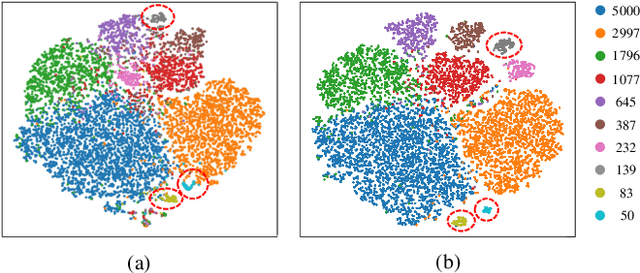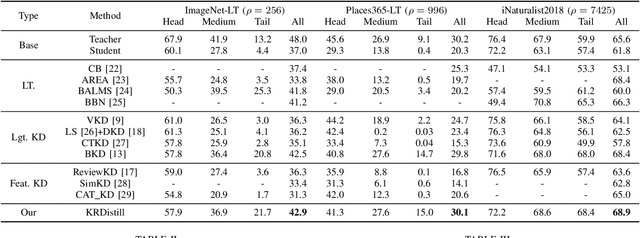Ning Jiang
School of Software & Microelectronics, Peking University, Beijing, China, Mashang Consumer Finance Co., Ltd., Chongqing, China
When Large Multimodal Models Confront Evolving Knowledge:Challenges and Pathways
May 30, 2025Abstract:Large language/multimodal models (LLMs/LMMs) store extensive pre-trained knowledge but struggle to maintain consistency with real-world updates, making it difficult to avoid catastrophic forgetting while acquiring evolving knowledge. Previous work focused on constructing textual knowledge datasets and exploring knowledge injection in LLMs, lacking exploration of multimodal evolving knowledge injection in LMMs. To address this, we propose the EVOKE benchmark to evaluate LMMs' ability to inject multimodal evolving knowledge in real-world scenarios. Meanwhile, a comprehensive evaluation of multimodal evolving knowledge injection revealed two challenges: (1) Existing knowledge injection methods perform terribly on evolving knowledge. (2) Supervised fine-tuning causes catastrophic forgetting, particularly instruction following ability is severely compromised. Additionally, we provide pathways and find that: (1) Text knowledge augmentation during the training phase improves performance, while image augmentation cannot achieve it. (2) Continual learning methods, especially Replay and MoELoRA, effectively mitigate forgetting. Our findings indicate that current knowledge injection methods have many limitations on evolving knowledge, which motivates further research on more efficient and stable knowledge injection methods.
Harnessing On-Device Large Language Model: Empirical Results and Implications for AI PC
May 22, 2025Abstract:The increasing deployment of Large Language Models (LLMs) on edge devices, driven by model advancements and hardware improvements, offers significant privacy benefits. However, these on-device LLMs inherently face performance limitations due to reduced model capacity and necessary compression techniques. To address this, we introduce a systematic methodology -- encompassing model capability, development efficiency, and system resources -- for evaluating on-device LLMs. Our comprehensive evaluation, encompassing models from 0.5B to 14B parameters and seven post-training quantization (PTQ) methods on commodity laptops, yields several critical insights: 1) System-level metrics exhibit near-linear scaling with effective bits-per-weight (BPW). 2) A practical threshold exists around $\sim$3.5 effective BPW, larger models subjected to low-bit quantization consistently outperform smaller models utilizing higher bit-precision. 3) Quantization with low BPW incurs marginal accuracy loss but significant memory savings. 4) Determined by low-level implementation specifics power consumption on CPU, where computation-intensive operations spend more power than memory-intensive ones. These findings offer crucial insights and practical guidelines for the efficient deployment and optimized configuration of LLMs on resource-constrained edge devices. Our codebase is available at https://github.com/simmonssong/LLMOnDevice.
Harnessing Large Language Models Locally: Empirical Results and Implications for AI PC
May 21, 2025Abstract:The increasing deployment of Large Language Models (LLMs) on edge devices, driven by model advancements and hardware improvements, offers significant privacy benefits. However, these on-device LLMs inherently face performance limitations due to reduced model capacity and necessary compression techniques. To address this, we introduce a systematic methodology -- encompassing model capability, development efficiency, and system resources -- for evaluating on-device LLMs. Our comprehensive evaluation, encompassing models from 0.5B to 14B parameters and seven post-training quantization (PTQ) methods on commodity laptops, yields several critical insights: 1) System-level metrics exhibit near-linear scaling with effective bits-per-weight (BPW). 2) A practical threshold exists around $\sim$3.5 effective BPW, larger models subjected to low-bit quantization consistently outperform smaller models utilizing higher bit-precision. 3) Quantization with low BPW incurs marginal accuracy loss but significant memory savings. 4) Determined by low-level implementation specifics power consumption on CPU, where computation-intensive operations spend more power than memory-intensive ones. These findings offer crucial insights and practical guidelines for the efficient deployment and optimized configuration of LLMs on resource-constrained edge devices. Our codebase is available at https://github.com/simmonssong/LLMOnDevice.
Device-aware Optical Adversarial Attack for a Portable Projector-camera System
Jan 23, 2025Abstract:Deep-learning-based face recognition (FR) systems are susceptible to adversarial examples in both digital and physical domains. Physical attacks present a greater threat to deployed systems as adversaries can easily access the input channel, allowing them to provide malicious inputs to impersonate a victim. This paper addresses the limitations of existing projector-camera-based adversarial light attacks in practical FR setups. By incorporating device-aware adaptations into the digital attack algorithm, such as resolution-aware and color-aware adjustments, we mitigate the degradation from digital to physical domains. Experimental validation showcases the efficacy of our proposed algorithm against real and spoof adversaries, achieving high physical similarity scores in FR models and state-of-the-art commercial systems. On average, there is only a 14% reduction in scores from digital to physical attacks, with high attack success rate in both white- and black-box scenarios.
AADNet: Exploring EEG Spatiotemporal Information for Fast and Accurate Orientation and Timbre Detection of Auditory Attention Based on A Cue-Masked Paradigm
Jan 07, 2025Abstract:Auditory attention decoding from electroencephalogram (EEG) could infer to which source the user is attending in noisy environments. Decoding algorithms and experimental paradigm designs are crucial for the development of technology in practical applications. To simulate real-world scenarios, this study proposed a cue-masked auditory attention paradigm to avoid information leakage before the experiment. To obtain high decoding accuracy with low latency, an end-to-end deep learning model, AADNet, was proposed to exploit the spatiotemporal information from the short time window of EEG signals. The results showed that with a 0.5-second EEG window, AADNet achieved an average accuracy of 93.46% and 91.09% in decoding auditory orientation attention (OA) and timbre attention (TA), respectively. It significantly outperformed five previous methods and did not need the knowledge of the original audio source. This work demonstrated that it was possible to detect the orientation and timbre of auditory attention from EEG signals fast and accurately. The results are promising for the real-time multi-property auditory attention decoding, facilitating the application of the neuro-steered hearing aids and other assistive listening devices.
Towards Interactive Deepfake Analysis
Jan 02, 2025



Abstract:Existing deepfake analysis methods are primarily based on discriminative models, which significantly limit their application scenarios. This paper aims to explore interactive deepfake analysis by performing instruction tuning on multi-modal large language models (MLLMs). This will face challenges such as the lack of datasets and benchmarks, and low training efficiency. To address these issues, we introduce (1) a GPT-assisted data construction process resulting in an instruction-following dataset called DFA-Instruct, (2) a benchmark named DFA-Bench, designed to comprehensively evaluate the capabilities of MLLMs in deepfake detection, deepfake classification, and artifact description, and (3) construct an interactive deepfake analysis system called DFA-GPT, as a strong baseline for the community, with the Low-Rank Adaptation (LoRA) module. The dataset and code will be made available at https://github.com/lxq1000/DFA-Instruct to facilitate further research.
Learn from Balance: Rectifying Knowledge Transfer for Long-Tailed Scenarios
Sep 12, 2024



Abstract:Knowledge Distillation (KD) transfers knowledge from a large pre-trained teacher network to a compact and efficient student network, making it suitable for deployment on resource-limited media terminals. However, traditional KD methods require balanced data to ensure robust training, which is often unavailable in practical applications. In such scenarios, a few head categories occupy a substantial proportion of examples. This imbalance biases the trained teacher network towards the head categories, resulting in severe performance degradation on the less represented tail categories for both the teacher and student networks. In this paper, we propose a novel framework called Knowledge Rectification Distillation (KRDistill) to address the imbalanced knowledge inherited in the teacher network through the incorporation of the balanced category priors. Furthermore, we rectify the biased predictions produced by the teacher network, particularly focusing on the tail categories. Consequently, the teacher network can provide balanced and accurate knowledge to train a reliable student network. Intensive experiments conducted on various long-tailed datasets demonstrate that our KRDistill can effectively train reliable student networks in realistic scenarios of data imbalance.
AnyDesign: Versatile Area Fashion Editing via Mask-Free Diffusion
Aug 21, 2024



Abstract:Fashion image editing aims to modify a person's appearance based on a given instruction. Existing methods require auxiliary tools like segmenters and keypoint extractors, lacking a flexible and unified framework. Moreover, these methods are limited in the variety of clothing types they can handle, as most datasets focus on people in clean backgrounds and only include generic garments such as tops, pants, and dresses. These limitations restrict their applicability in real-world scenarios. In this paper, we first extend an existing dataset for human generation to include a wider range of apparel and more complex backgrounds. This extended dataset features people wearing diverse items such as tops, pants, dresses, skirts, headwear, scarves, shoes, socks, and bags. Additionally, we propose AnyDesign, a diffusion-based method that enables mask-free editing on versatile areas. Users can simply input a human image along with a corresponding prompt in either text or image format. Our approach incorporates Fashion DiT, equipped with a Fashion-Guidance Attention (FGA) module designed to fuse explicit apparel types and CLIP-encoded apparel features. Both Qualitative and quantitative experiments demonstrate that our method delivers high-quality fashion editing and outperforms contemporary text-guided fashion editing methods.
Whisper-SV: Adapting Whisper for Low-data-resource Speaker Verification
Jul 14, 2024



Abstract:Trained on 680,000 hours of massive speech data, Whisper is a multitasking, multilingual speech foundation model demonstrating superior performance in automatic speech recognition, translation, and language identification. However, its applicability in speaker verification (SV) tasks remains unexplored, particularly in low-data-resource scenarios where labeled speaker data in specific domains are limited. To fill this gap, we propose a lightweight adaptor framework to boost SV with Whisper, namely Whisper-SV. Given that Whisper is not specifically optimized for SV tasks, we introduce a representation selection module to quantify the speaker-specific characteristics contained in each layer of Whisper and select the top-k layers with prominent discriminative speaker features. To aggregate pivotal speaker-related features while diminishing non-speaker redundancies across the selected top-k distinct layers of Whisper, we design a multi-layer aggregation module in Whisper-SV to integrate multi-layer representations into a singular, compacted representation for SV. In the multi-layer aggregation module, we employ convolutional layers with shortcut connections among different layers to refine speaker characteristics derived from multi-layer representations from Whisper. In addition, an attention aggregation layer is used to reduce non-speaker interference and amplify speaker-specific cues for SV tasks. Finally, a simple classification module is used for speaker classification. Experiments on VoxCeleb1, FFSVC, and IMSV datasets demonstrate that Whisper-SV achieves EER/minDCF of 2.22%/0.307, 6.14%/0.488, and 7.50%/0.582, respectively, showing superior performance in low-data-resource SV scenarios.
Modeling, Inference, and Prediction in Mobility-Based Compartmental Models for Epidemiology
Jun 17, 2024Abstract:Classical compartmental models in epidemiology often struggle to accurately capture real-world dynamics due to their inability to address the inherent heterogeneity of populations. In this paper, we introduce a novel approach that incorporates heterogeneity through a mobility variable, transforming the traditional ODE system into a system of integro-differential equations that describe the dynamics of population densities across different compartments. Our results show that, for the same basic reproduction number, our mobility-based model predicts a smaller final pandemic size compared to classic compartmental models, whose population densities are represented as Dirac delta functions in our density-based framework. This addresses the overestimation issue common in many classical models. Additionally, we demonstrate that the time series of the infected population is sufficient to uniquely identify the mobility distribution. We reconstruct this distribution using a machine-learning-based framework, providing both theoretical and algorithmic support to effectively constrain the mobility-based model with real-world data.
 Add to Chrome
Add to Chrome Add to Firefox
Add to Firefox Add to Edge
Add to Edge